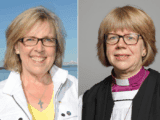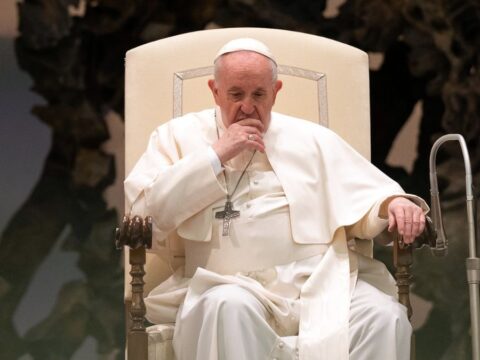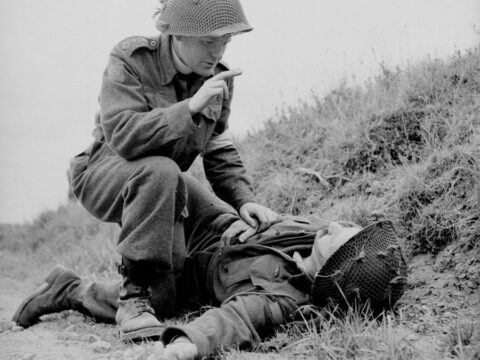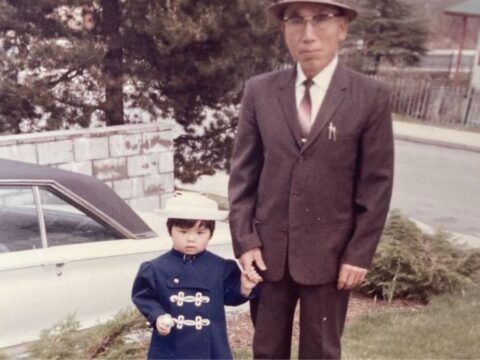On Christmas Eve in 1668, a 14-year-old Wendat girl named Therese lay on her deathbed, singing about the birth of Christ. She would pass away the next day, possibly from a European-borne disease.
Later, a Jesuit priest named François-Joseph Le Mercier told Therese’s story in a letter addressed to his superiors in France, writing “she began to sing ‘Jesus is going to be born’ — which is an air sung by the Hurons on Christmas Festivals.”
You may unsubscribe from any of our newsletters at any time.
Le Mercier’s letter is the first known reference to what is now commonly called the Huron Carol, a Christmas song in the Wendat language, likely written sometime in the early 1640s by the French Jesuit missionary Jean de Brébeuf. (“Huron” was initially a European descriptor of the Wendat people, and can carry derogatory overtones. In Wendat, the song is called Jesous Ahatonnia, which means “Jesus is Born.”)
The death of Therese was one of many Le Mercier reported in his writing. If he was saddened by these Indigenous deaths, his letters don’t show it. In fact, he often celebrated the demise of the Wendat. The “Huron Mission has been especially rich, these last two years, in illustrious deaths,” he wrote, pleased with the Christian faith he observed in many Wendat during their final hours.
Therese’s community had lived through a tumultuous half-century. The Wendat confederacy numbered around 25,000 people before Europeans made contact with them in the early 17th century, but by the 1640s as many as half of them had died of European diseases. A war with the Iroquois in the late 1640s destroyed many of their villages and killed even more of their people, forcing a dispersal from their traditional territory between Lake Simcoe and Georgian Bay, in what is now Ontario.
In 1650, about 300 Wendat fled to a mission in New France, carrying the Christmas carol they had learned with them on the 50-day journey east (others fled south into what would become the United States). The French continued to relocate the Wendat, but they were finally settled permanently in 1697, in a village just north of Quebec City called Lorette. Now named Wendake, this community survives — and thrives — to this day, with a population of about 2,000.
She couldn’t have known it, but Therese’s Christmas Eve recitation of Jesous Ahatonnia anticipated a long tradition. The Jesuits were successful in Christianizing the Wendat people, and for hundreds of years l’Église Notre-Dame-de-Lorette, the small Catholic church in Wendake, would ring out with the sounds of the carol at Christmastime. Today the song is still sung in Wendat at the church, where it is afforded a special place in Christmas masses, usually as the communion or the opening hymn.
Outside of Wendake, the song has become even more popular. Often celebrated as “the first Canadian Christmas carol” and received as an example of Indigenous heritage, it has been recorded many times and is a Christmas concert staple. It inspired at least four illustrated picture books and was even honoured with a national series of postage stamps in 1977.
But for some, the colonial context of the song’s origin complicates its meaning today. The carol represents not just the birth of Jesus in and for North America, but the delivery of the Gospel by European missionaries. As such, the song’s history is intertwined with the destructive presence of the church in Indigenous communities. In the 1950s, the Missionary Society of the Church of England in Canada recommended screening a National Film Board documentary about the carol in Canada’s residential schools, illustrating the song’s potential power to assimilate.
Nevertheless, many Indigenous Christians in North America have embraced the Huron Carol and sing it every Christmas season. The carol has come to occupy a significant place in the cultural history of Canada as a whole, but its messy lineage and complex legacy are often overlooked when, each December, it is performed yet again.

On a brisk autumn Sunday earlier this year, about 40 people sat in the wooden pews of l’Église Notre-Dame-de-Lorette in Wendake, many of them keeping their coats and jackets on, as if anticipating a quick departure. With the exception of one young family sitting in the back, the congregation was noticeably aging. A visiting priest presided over the mass in French, and three choristers led the congregation in the hymns. Outside the red and white stucco church, the St. Charles River, which is known in Wendat as Akiawenrahk, rushed by in rapids on its way to the St. Lawrence.
Notre-Dame-de-Lorette was built in 1730, then rebuilt in the 1860s after it was largely destroyed by a fire. The church is home to an exquisite collection of colonial Catholic artifacts. Rescued during the fire, they still adorn the altar, shimmering in shades of gold and silver. Today, the Catholic ornaments are accompanied by Indigenous ones. A dream catcher is hung next to a crucifix on the wall, a miniature canoe is suspended from the altar, and below that, animal pelts, dried corn and snowshoes are artfully arranged on the carpet.
When the mass is over, the congregation shuffles out the front door quickly, leaving just a few people chatting in the church, one of them Jean-Pierre Gros-Louis, who has been organist and choir director here for more than a quarter-century.
Gros-Louis has witnessed a lot of change in this church. As with the rest of Quebec, where 75 percent of people identify as Catholic but only 11 percent attend services, involvement with the church in Wendake has plummeted in recent decades. Gros-Louis remembers a time when there were four masses full of people every Sunday (the church can hold more than 100). Now there is only one sparsely attended mass each week, which may soon be reduced to a biweekly or monthly schedule. “The Christian community is quietly fading away,” says Gros-Louis, who struggles to find volunteers for the choir.
For those who remain, Jesous Ahatonnia is one way of connecting to the community’s past. Over tea at a restaurant just outside Wendake, local Wendat Catholic Claude Vincent says he is brought “back to the motherland” when he sings Jesous Ahatonnia. “All my aunts sang that song when I was young,” he recalls. “So it stirs a lot of memories.”
The song is also a connection to a lost language. While the Wendat people continued to speak their language after the move to New France, gradual intermarriage with French speakers — as well as the imperatives of doing business in French after other traditional ways of life were made impossible — caused the Wendat language to practically disappear by the 1850s. For a long time, Christmas recitations of Jesous Ahatonnia were one of the few occasions the language could have been heard. To this day, despite the song having been translated into French, the congregation usually sings it in Wendat, opting for the words their ancestors would have known.
“I hear the lyrics, but I don’t understand them,” admits organist Gros-Louis. “There is still a great pride in singing that song. We try as much as possible to at least pronounce it correctly.” Gros-Louis first learned the carol in primary school, but he doesn’t hear it much outside the church anymore. “It has more meaning for the Christians” in Wendake than the non-Christians, he says.
Jesous Ahatonnia is a living tradition in this small church. It has been sung here longer than anywhere else in North America. But as the Catholic community in Wendake shrinks, there is a sense the song is becoming an artifact, one whose value lies in its history rather than its present.

“Estenniayon de tsonwe Jesous ahatonnia,” begins Jesous Ahatonnia, or, according to an English translation by Wendat language researcher John Steckley, “Have courage, you who are humans; Jesus is born.” The song is one of the earliest recountings of the Christ story in an Indigenous language. By the time it was composed, de Brébeuf had lived among the Wendat people in their traditional territory for years. He could speak their language, and he was exploiting his familiarity with Wendat culture to steer them toward Christian conversion.
Set to the tune of a traditional French folk song (the same tune as today’s Huron Carol), Jesous Ahatonnia would have made a strong impact on the Wendat people, for whom music was already significant. (The Wendat language contains at least eight different words for “singing” and “song.”) Teaching Christian songs in Indigenous languages was a common and often successful missionary practice among the Jesuits. “It is a sweet consolation to hear them sing publicly, in our Chapel, the Apostles’ creed in their own language,” wrote Paul Le Jeune, a Jesuit contemporary of de Brébeuf’s. “They like this so well that they make this holy and sacred song resound everywhere.”
The writing of Jesous Ahatonnia, as with all de Brébeuf’s work in North America, followed the Jesuits’ particular missionary strategy: full immersion into the culture of the targeted community — including adopting its language and customs — in order to earn people’s trust and convert them. “Thus after gaining [a potential convert’s] confidence we shall meet with better success,” wrote Jesuit founder Ignatius of Loyola. “In this sense we enter his door with him, but we come out our own.”
In keeping with this advice, de Brébeuf’s song presents the Christ story using images and ideas familiar to the Wendat. Angels are styled as “spirits” and “sky people.” The three wise men are described as “elders,” and they oil Jesus’ scalp, a practice Wendat people would have recognized. Elsewhere, de Brébeuf speaks of the Christian God using the Wendat term wendio, or “great voiced,” which originally referred to political and social leaders in Wendat society (because they would speak for their clans).
De Brébeuf may have been using Wendat words, but the song, and the Jesuit mission among the Wendat as a whole, was reflective of a wider colonial project: that of erasing and replacing Indigenous customs and beliefs. The Jesuits taught the Wendat people that Christianity was superior to their traditional practices, and many came to accept this idea. As Wendat people converted, they began to withdraw from their community’s traditional ceremonies and feasts, leading to conflicts within the community. Louis-Jacques Dorais, an anthropologist at Université Laval in Quebec, suggests that these conflicts weakened community ties and contributed to the Wendat military defeat at the hands of the Iroquois in the late 1640s.
For some interpreters, Jesous Ahatonnia is implicated in this history. After its opening line, the song continues, “Behold, it has fled, the spirit who held us prisoner / Do not listen to it, it corrupts our minds.” Michel Savard, a member of the Huron-Wendat Nation who works in the community as a museum curator, says those words were a warning to Wendat people to avoid their own spirituality, labelling it as a work of the devil. In this reading, which isn’t Savard’s alone, the birth of Jesus is supposed to liberate the Wendat people from the prison of their traditional practices. It means Wendat beliefs “are over, they’re worthless, they’re nonsense,” Savard says. “Christianity destroyed a part of us.”
Savard calls Jesous Ahatonnia manipulative, and he says it doesn’t mean anything to him. While other non-Christians in the community appreciate the song as part of their heritage, even if its theology no longer resonates, Savard would consider it no great loss if the song disappeared from Wendake. “The song was meant for us,” he says, “but I have a feeling it has been more important outside of our nation.”
The carol represents not just the birth of Jesus in and for North America, but the delivery of the Gospel by European missionaries
How did de Brébeuf’s song become so well known outside Wendake? For most of its history, Jesous Ahatonnia was relatively obscure, passed down orally from one generation to another in the community (if de Brébeuf made a written copy, it has been lost). A Jesuit priest wrote down the Wendat words in the late 18th century, but the song didn’t begin to gain a wider currency until translations were made.
A Wendat chief, Paul Tsawenhohi Picard, made a French translation that was published in 1899, and in 1927 a Canadian poet named Jesse Middleton (who was not Indigenous) published English lyrics in a small illustrated book called The First Canadian Christmas Carol. It is Middleton’s version that is most commonly associated with the song today, with its evocative opening lines:
’Twas in the moon of wintertime
When all the birds had fled
That mighty Gitchi Manitou
Sent angel choirs instead.
Middleton’s words are not a translation, but a complete rewriting of Jesous Ahatonniafor English speakers. His lyrics bear almost no relation to the original Wendat text, and critics say Middleton relied on his own stereotypical understanding of Indigenous people to write them. Among the many errors that are pointed out is that Gitchi Manitou is not a Wendat term, but Algonquian.
“The translation is a romantic version done by a non-Indigenous person and leaves out some of the emphasis of the original,” says Mark MacDonald, the national Indigenous bishop of the Anglican Church of Canada. “My under-standing is that Jesus in the original is placed more firmly in the cosmology and world view of Wendat people.”
Still, English speakers in North America loved Middleton’s lyrics. W. S. Wallace, writing in the The Canadian Historical Review in 1927, said that the original carol “contains little that is striking; but Mr. Middleton’s rendering in English is a charming piece of work.”
Middleton’s words appeared in the hymnbook produced jointly by The United Church of Canada and the Anglican Church of Canada in 1971, and again in those denominations’ subsequent hymnals Voices United (1996) and Common Praise (1998). It is through Middleton’s words that English speakers have imagined an Indigenous Nativity, with “hunter braves” replacing the shepherds in the field, a “lodge of broken bark” standing in for the manger and “gifts of fur and beaver pelt” being delivered by “Chiefs from far.”
John Steckley, a retired college professor and Indigenous language researcher, says that while the original song struck a balance between European and Indigenous vocabularies of the sacred, Middleton’s translation is rooted in European ideas and representations of Indigenous people. Steckley is not Indigenous himself, but he has spent most of his career studying the Wendat language and currently serves as the tribal linguist for the Wyandotte of Oklahoma. Steckley has argued that interpreters and translators of Jesous Ahatonnia have gradually removed the song from its Indigenous context. Indeed, it is hard to see how Middleton’s imaginative lyrics, written by a British-born Canadian and set to a traditional French folk tune, could be called Indigenous at all.
Jesous Ahatonnia
Estenniayon de tsonwe Jesous ahatonnia
onn’ awatewa nd’ oki n’ onyouandaskwaentak
ennonchien eskwatrihotat n’onyouandiyonrachatha
Jesous ahatonnia, ahatonnia. Jesous ahatonnia.
Ayoki onkiennhache eronhiayeronnon
iontonk ontatiande ndio sen tsatonnharonnion
Warie onn’ awakweton ndio sen tsatonnharonnion
Jesous ahatonnia, ahatonnia. Jesous ahatonnia.
Achienhkontahonraskwa d’ hatirihwannens
tichion sayonniondetha onhwa achia ahatren
ondaie te hahahakwa tichion sayonniondetha
Jesous ahatonnia, ahatonnia. Jesous ahatonnia.
Tho ichien st’ ahation tethotondi Jesous
ahwatatende tichion stanchitehawennion
asayontorenten ihatonk atsion sken
Jesous ahatonnia, ahatonnia. Jesous ahatonnia.
Onne ontahation chiahonayen Jesous
ahatichiennonniannon kahachia handiayon
te honannonronkwannion ihotonk werisen
Jesous ahatonnia, ahatonnia. Jesous ahatonnia.
Te hekwatatennonten ahekwachiendaen
ti hekwannonronkwannion de sonywentenrände
outoyeti skwannonhwe icherhe akennonhonstha
Jesous ahatonnia, ahatonnia. Jesous ahatonnia.
[The orthography of the Wendat language was only recently standardized, and there are various transcriptions of Jesous Ahatonnia in use. The above was provided by Arakwa Sioui of the Huron-Wendat First Nation.]
And yet, Middleton’s translation made the song accessible to English-speaking Indigenous Christians across North America, and many have embraced it. Even as he acknowledges the problems with Middleton’s text, Mark MacDonald says that “at a kind of primary level, Indigenous people have seen it as an embodiment of an Indigenous response to the Christian faith, which is very, very important.”
In his travels to Indigenous communities in Canada and the United States, MacDonald has heard the Huron Carol sung in many Indigenous churches. But he says children acting out the song is even more common. “One of the places where I was struck deeply at the acting out of the hymn was in Navajo land [in southwest United States], when the young kings or the wise men were all dressed in traditional Navajo attire,” MacDonald remembers. “The proud bringing of that attire and that world view into the church . . . was deeply moving.”
For the many non-Indigenous Canadians whose Christmas traditions include singing the Huron Carol, the reconciliation movement has called into question the appropriateness of performing the song, leading some to reach out to Indigenous Christians for guidance. Earlier this year, a community choir in Calgary asked Tony Snow, a member of the Stoney Nakoda Nation and co-ordinator of community and pastoral care at McDougall United in Calgary, for his reflections. Snow emphasized the importance of not only interrogating the colonial intentions of the early missionaries, but also of honouring the creative ways Indigenous people responded to Christianity, and the spiritual generativity that resulted from the meeting of the two cultures. Snow believes Jesous Ahatonnia is an example of this kind of spiritual exchange. “The song is a marriage between Christian and Wendat belief systems,” he says, “and was used to bridge understandings and build better relationships.”
Snow acknowledges that some of the English translations used today can sound “altogether racist to modern listeners.” He says one solution to this is “to learn the original version, honour it and find an English version that holds true to the original intent.” Doing so may itself be an act of reconciliation, modelled on the song’s original author: “de Brébeuf took the time to immerse himself in [Wendat] culture, learn the language and honour his hosts with [the Huron Carol],” Snow says.“This mindfulness should be our model of understanding in reconciliation.”
In recent decades, it has become more common to perform Jesous Ahatonnia in Indigenous languages. Steckley says he often receives requests in the fall from artists looking to sing the carol in Wendat at Christmastime but who need help pronouncing and understanding the original words. Non-Indigenous artists like Bruce Cockburn and the Toronto Consort were some of the first to resurrect the Wendat words for a wide audience (they have always been sung in Wendake), and judging from the large number of performances recorded on YouTube, non-Indigenous people make up the majority of those performing the song in Wendat.
On the other hand, Indigenous artists like Susan Aglukark, the Eskasoni Trio and Dolores Sand have also performed the song but in their respective Indigenous languages: Inuktitut, Mi’kmaw and Cree. Tom Jackson is perhaps the most well-known Indigenous performer associated with the song: his “Huron Carole” Christmas charity concert has toured the country since 1987 raising money for food banks. It returns again this Christmas season.
Steckley calls this new excitement for performing Jesous Ahatonnia in Indigenous languages the “re-Indigenization” of the song, and he is especially encouraged by the new interest in the Wendat lyrics. “Languages can live in many different ways,” he says. “This is a way a language comes back to life. Every path it takes is a good one.”

But a true revival of the Wendat language will only happen in a community context where people are committed to speaking it regularly. In Wendake, an ambitious project is underway to reconstruct and revitalize the language and then teach it to the next generation. It’s already having an impact: people regularly greet each other in Wendat, street signs include Wendat words, and Wendat ceremonies are performed using traditional language.
Arakwa Sioui is one of the Wendat linguists at the centre of the revitalization efforts. “It’s important to me because it’s our identity,” she says. “If there is no language, there is no affirmation of culture. It goes together: culture, language, history, spirituality.”
The revitalization project has relied on oral memory, comparative studies of similar languages like Mohawk and Seneca, and archival documents (mostly Jesuit grammars and dictionaries) to reconstruct the language. While Wendat people had wanted to relearn their language since at least the early 1970s, and had begun to do so casually, it was only when funding was granted for the project through Canada’s Social Sciences and Humanities Research Council in 2007 that the work was able to begin in earnest. Sioui says that while the reconstruction will take a long time and a lot of effort, she hopes her grandchildren will speak the language at least a little.
The team is also focusing on traditional Wendat songs, many of which are likely thousands of years older than Jesous Ahatonnia. Like the Christmas carol, they were preserved orally even after the community stopped speaking Wendat. When the language was lost, the sounds of the words were still handed down and remembered, Sioui says.
Perhaps tellingly, Jesous Ahatonnia has not featured prominently in the language revitalization efforts. “Our priority right now is not [Jesous Ahatonnia]. We are working on our traditional songs for our ceremonies,” Sioui says. She also notes that the inherited Wendat text of Jesous Ahatonnia contains errors. Its grammar is awkward, and Sioui doesn’t recognize all the words. The awkwardness of the text betrays its European authorship, she says. Jesous Ahatonnia “is not a part of our real culture,” she continues. “It’s a song that was written [by] somebody else.”
The language renaissance in Wendake has been driven by a broader revival of traditional Wendat practices that has been ongoing for about 40 years. In 1989, for example, a group calling themselves “traditionalists” built a long house in Wendake and began to practise traditional Wendat rituals, first using the Mohawk language, then using Wendat.
Michel Savard, the museum curator, remembers his early explorations of traditional Wendat spirituality during that time, when he was in his 20s. “These were rituals that existed for thousands of years, then forgotten for 200 years,” he says. “People felt like there was an ember inside them. We just had to blow on it to light the fire again.”
Now, “the ancient rituals are coming back strong,” Savard says. “At cultural events, at community festivals, more and more we’re including our traditions in our celebrations.” The Wendake community is increasingly claiming and celebrating their traditional identity. As members of the community relearn their ancestral language and re-engage with their traditional spiritual practices, they are reaching much deeper into their history than the 17th century, beyond the time of the Jesuits and Jesous Ahatonnia. That gives the Huron Carol a paradoxical significance here; it is a part of the community’s heritage, but not the heritage many are working hard to recover.
This doesn’t mean the song is likely to be forgotten in Wendake. It may have been made for Christian purposes and its text may be awkward, but Sioui believes her community will continue to sing it, “to make our ancestors live on,” she says. “We hold it in our hearts because it comes from our ancestors and they sang it.”
Additional reporting by Mugoli Samba.
This feature first appeared in The Observer’s December 2018 issue.














